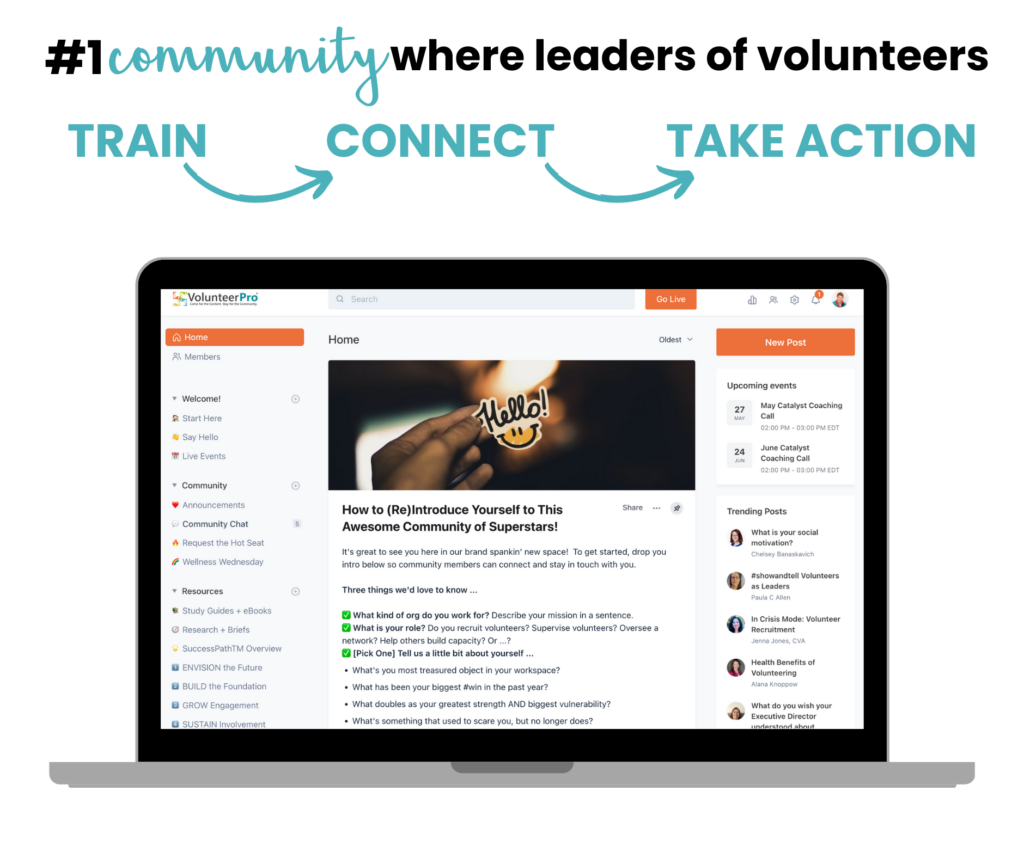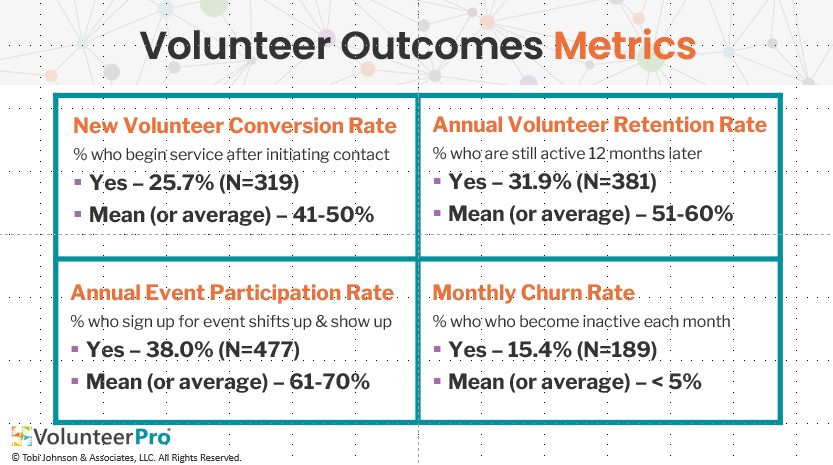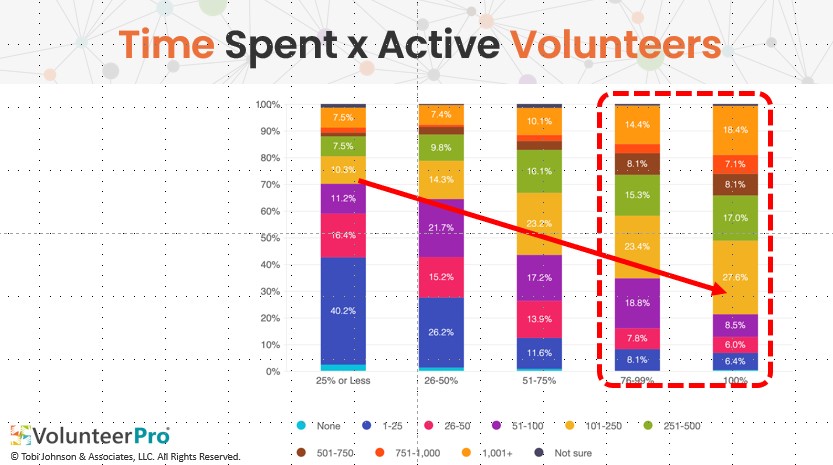How to Boost Volunteer Recruitment with These Outcome Metrics
As joyful and rewarding as nonprofit work can be, the standard workday for many also often includes long hours, constant interruptions, and a million pressing tasks that seem to eat away at your staff’s precious time.
Too often, this is because organizations do not have effective systems in place to accurately track outcome metrics, which results in employees who spend the bulk of their time – with great intentions – reactively responding to urgent daily needs rather than focusing on long-term strategic planning.
This is especially true for volunteer-involving organizations, who face the additional challenges of recruiting, retaining, managing, and measuring the impact of a dynamic unpaid workforce whose service is vital in accomplishing the mission of your nonprofit.
Good news: establishing benchmarks for measurable volunteer outcome metrics is possible, and doing so will help your staff save time and work more efficiently by quickly identifying what processes are working, which areas need improvement, which strategies are no longer relevant, and which ones are simply time wasters.
Knowing where to correctly focus valuable time will help streamline your organization’s processes and increase your capacity to serve your community’s needs. It will also impact your organization’s ability to effectively boost your volunteer recruitment and retain volunteer talent.
For more ideas on how to boost volunteer recruitment, check out these 6 Creative Ways to Recruit Volunteers HERE>>
Data is Key for Effective Volunteer Recruitment
Every year, VolunteerPro releases our state-of-the-industry Volunteer Management Progress Report to shine a light on current nonprofit trends. The data in this year’s report, released in January 2023, was tabulated based on survey responses from nearly 1,400 leaders of volunteers in 36 countries around the world.
When asked about issues surrounding volunteers, over 34% of this year’s respondents listed recruitment as their number one challenge. Many shared a sentiment similar to this one: “new volunteers aren’t submitting applications…our recruitment measures just aren’t working!”
Without meaningful data to understand why current recruiting efforts are falling short, it’s very easy to make the flawed assumption that “people just don’t want to volunteer anymore” (another recurring comment from survey respondents).
Not only is this assumption incorrect (as evidenced by the hundreds of vibrant, growing volunteer programs also represented in this year’s report), it is also incredibly self-defeating. If your team believes that their volunteer recruitment efforts are doomed to fail, they almost certainly will be.
Without the data, your team really has no way to know for sure. This year’s survey results indicate that very few nonprofits (less than a third) are actively tracking volunteer outcome metrics, which unfortunately leaves many without the vital information necessary to correct course and improve results.
Boost Volunteer Recruitment with 4 Key Volunteer Outcome Metrics
These four metrics are key performance indicators for every volunteer volunteer-involving organization’s overall program health:
- New Volunteer Conversion Rate – % who begin service after initiating contact
- Annual Volunteer Retention Rate – % who are still active 12 months later
- Annual Event Participation Rate – % who sign up for event shifts and show up
- Monthly Churn Rate – % who become inactive each month
Data from these metrics can help your team to identify pinch points in the volunteer life cycle, so you can more accurately identify underlying reasons why a process “just isn’t working” and make needed adjustments to more effectively your boost volunteer recruitment efforts.
If, for instance, your new volunteer conversion rate is low, you could look at your application process for ways to simplify the process and open the door wider for those interested.
If your new volunteer conversion rate is robust but your monthly churn rate is high, you examine your training and onboarding for areas that might be intimidating or confusing for new volunteers.
If your annual volunteer retention rates indicate that volunteers aren’t staying past a year, you could dig deeper into your volunteer experience to improve areas that may be hindering a sense of community, identity, and engagement.
Tracking “micro-conversions” at each step, from recruitment through onboarding, will help to diagnose where your current system may be failing you.
A word of encouragement on the metrics above: you and your team can decide what terms like “first contact” (Web inquiry? Phone call?) and “inactive” (No contact? Away at school?) mean for your organization. Just make sure to apply whatever standard you set across the board.
Want more ideas on key data points to boost volunteer recruitment? Check out these Nonprofit KPIs Your Volunteer Program Should be Tracking HERE>>
How Outcome Metrics Can Save Time and Reduce Burnout
As I mentioned earlier, volunteer recruitment was by far the number one concern for respondents in this year’s Volunteer Management Progress Report. The second biggest concern: time.
Working to meet the same expectations with fewer staff, managing increased workloads, and dividing time between competing priorities – these challenges all contributed to an overall sense of not having enough time to do it all well. Additionally, both employee and volunteer burnout were emerging challenges in this year’s results that were not mentioned by respondents in previous surveys.
Setting up systems to track key volunteer outcome metrics can greatly help in this area of concern. Burnout prevention, as well as time management in general, begins with a plan. And in order to create a plan that works, you’re going to need data.
Is burnout an issue in your organization? Check out these 6 Ways to Prevent Burnout in Nonprofits HERE>>
In much the same way as your blood pressure, cholesterol levels, and current weight are quick indicators to your medical care providers of potential issues, your volunteer program’s churn, conversion, and retention rates reveal your program’s current health and areas that need your attention.
Staying on top of your outcome metrics can alleviate a great deal of the stress that comes from simply not knowing what’s really happening in your program. It also provides clear action steps and measurable benchmarks to track future growth.
Outcome Metrics Help Your Whole Volunteer Program Grow
In addition to more effective recruitment and reduced burnout, providing teams the necessary time to work on a volunteer program rather than in it has great benefits for organizations as a whole.
This year’s survey results show a clear correlation between time investments in a volunteer program and increased volunteer engagement.
On average, less than half of current volunteer managers spend more than three-quarters of their time directly working on volunteer program administration, including data management. However, more time spent correlates with a larger number of volunteers engaged, averaging 26-50 volunteers for those that spend 25% or less on volunteer management but 101-250 volunteers for those who devote all of their work time to volunteer engagement.
Additionally, the greater percentage of time volunteer coordinators spent on volunteer management, the higher the volunteer capacity rating, or the extent to which volunteer roles were filled.
Perhaps most telling, our research shows that budget clearly matters when volunteer managers reflect on the performance of their organizations with respect to volunteer engagement.
Over one-quarter (28.2%) of those who rated their organization’s progress toward reaching volunteer goals as “it is really bad” also had no annual budget for volunteer engagement. Alternately, those in the $10,001-$50,000 annual budget range represented an increased percentage from poor performance (It’s really bad) to good performance.
While the correlation between time/budget and reaching goals may seem obvious, many volunteer departments have been tasked the last few years with doing more with less…less time spent exclusively on volunteer program management, less volunteer department staff to fill roles and create meaningful volunteer experiences, and less investment from staff and leadership in nurturing a vibrant, organization-wide volunteer corps.
Post-pandemic, we need to change our strategy for volunteer program management, as well as the expectation that volunteer programs can thrive without the necessary benchmarks, data tracking, goal setting, and outcome metrics that other nonprofit departments accept as a core part of their process.
It will be the responsibility of forward-thinking volunteer managers to implement measurable benchmarks for volunteer outcomes and commit to tracking and acting on them regularly. And it will be the responsibility of nonprofit boards and executive staff to give volunteer programs the needed investment of time and resource if they want to see their programs move beyond merely surviving to truly thriving.
,  Move Beyond Surviving to Thriving with VolunteerPro Membership!
Move Beyond Surviving to Thriving with VolunteerPro Membership!
Outcome metrics, retaining talent, and boosting volunteer retention…these are just a few of the topics we cover within VolunteerPro’s Membership community. Within membership, you’ll find in-depth training on how to build a recruitment and retention strategy to boost volunteer recruitment more effectively and attract and engage supporters in your good works. You’ll also have access to monthly coaching calls to ask questions and get feedback on your campaign design.
Membership includes access to a huge digital library of what-works-now content, live monthly seminars, workshops, and coaching calls, as well as a vibrant community of volunteer leaders to share ideas and questions.
Enrollment for new members is open NOW.
.










